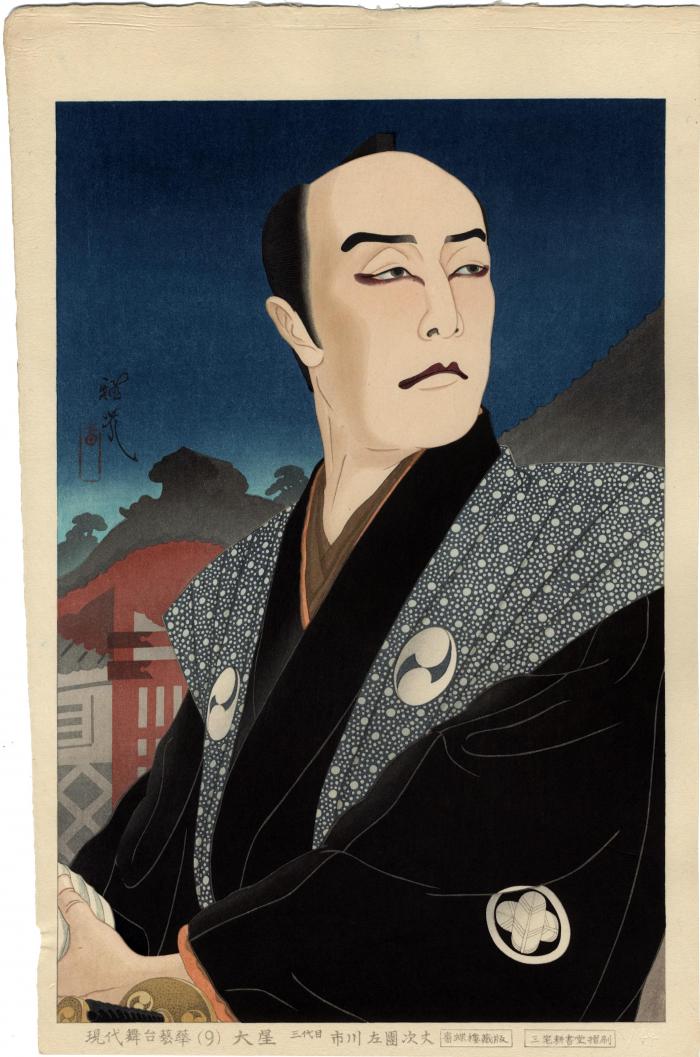Ōta Masamitsu (太田雅光) (artist 1892 – 1975)
Ichikawa Sadanji III (三代目 市川左團次) as Ōboshi (大星) Yuranosuke - Number 9 from the series Flowers of Contemporary Theatre (現代舞台芸花)
1954
10.625 in x 16.75 in (Overall dimensions) Japanese woodblock print
Signed: Masamitsu (雅光)
Artist's seal in red
Number - embossed in lower right: 144 [of 200]
Printer's seal in the lower right margin:
Miyake Koshodo shosatsu (三宅耕書堂摺摺刷)
Copyright: Banchōrō (番蝶楼蔵版)
Waseda University
Portland Art Museum
Art Gallery of Greater Victoria Illustrated in color on page 54 in Shin-hanga: New Prints in Modern Japan:
"Ninth in the latter series in Ichikawa Sadanji as Ōbashi Yuranosuke... Carved by Itō Susumu (b. 1916), who had worked previously for Watanabe, and printed by Itō Shuntarō (b. 1904), Masamitsu's print exhibits saturation in color. Sadanji III, who usually played nimaime (romantic young lovers) or onnagata roles in his youth, later starred as mature heroes. The older Sadanji III was well suited to portray Ōboshi Yuranosuke, hero of Kanadehon Chūshingura (The treasury of loyal retainers), who leads his band of masterless samurai to avenge the death of their master. In Masamitsu's powerful print we gaze up at the assured (and deeply modeled) face of Yuranosuke, who in the turbulent moments after the suicide of his lord briefly considers following his master in ritual death then resolves to defy the government and organize a clandestine attack on his master's persecutor.
Comparing Masamitsu's print of Yuranosuke with Toyonari's print of the same character... we witness the first and last stages of shin-hanga actor prints. The most obvious differences is the evolution toward naturalism, clearly evident in the effects of three-dimensionality and deep space achieved in Masamitsu's print. Although this naturalism detracts from the design quality of the print, it provides much clearer insight into the actor's ability to assume a dramatic persona. Masamitsu's print, as with the mature work of Shunsen, Toyonari, and even Kanpō, begins with the conception of actors as they are, then modifies this naturalistic view to accommodate traditional ukiyo-e conventions and decorative stylization. In short, shin-hanga inverts the balance of abstraction and naturalism found in the traditional ukiyo-e actor of Sharaku or Kunichika. In so doing, shin-hanga provides a visual analogue to Taishō and early Shōwa kabuki, where personality usually dominated performance and the harsh glare of electric light dispelled the romanticizing shadows of the past."
****
There is a bit of confusion in the art world as to whether or not this figure represents Sadanji II or III. Since Sadanji II is said to have died in 1940, we will go with Sadanji III.
****
The curatorial files from the Portland Museum of Art state:
"Ichikawa Sadanji II (1880-1940) was one of the most popular kabuki actors of the first half of the 20th century. He had an unusually cosmopolitan outlook, having traveled and studied in Europe and the USA as a young man. With a group of collaborators, he pushed for reform in the theater, developing both new plays (Shin kabuki) and successfully reviving classics. He is portrayed here in the role of Ōboshi Yuranosuke, leader of the masterless samurai in “Chūshingura (Treasury of Loyal Retainers).”
****
One internet web site says that the block carver was Itō Susumu (伊 藤進) and that it was printed by Satō Ritsuzō (佐藤 律三).
actor prints (yakusha-e - 役者絵) (genre)
modern prints (shin hanga - 新版画) (genre)
Chūshingura (忠臣蔵 - 47 Rōnin) (genre)
Ichikawa Sadanji III (三代目市川左団次: from May 1952 to October 3, 1969 ) (actor)
Banchōrō (番蝶楼) (publisher)
Shōwa era (昭和時代) (genre)
